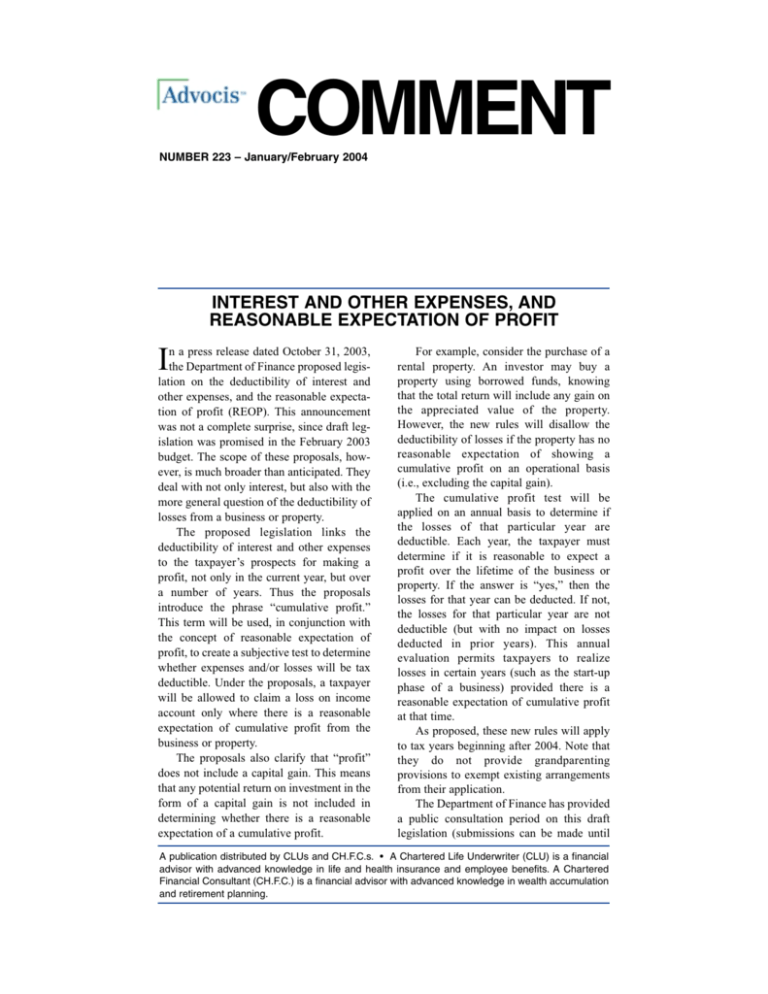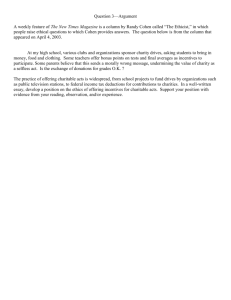
COMMENT
NUMBER 223 – January/February 2004
INTEREST AND OTHER EXPENSES, AND
REASONABLE EXPECTATION OF PROFIT
n a press release dated October 31, 2003,
the Department of Finance proposed legislation on the deductibility of interest and
other expenses, and the reasonable expectation of profit (REOP). This announcement
was not a complete surprise, since draft legislation was promised in the February 2003
budget. The scope of these proposals, however, is much broader than anticipated. They
deal with not only interest, but also with the
more general question of the deductibility of
losses from a business or property.
The proposed legislation links the
deductibility of interest and other expenses
to the taxpayer’s prospects for making a
profit, not only in the current year, but over
a number of years. Thus the proposals
introduce the phrase “cumulative profit.”
This term will be used, in conjunction with
the concept of reasonable expectation of
profit, to create a subjective test to determine
whether expenses and/or losses will be tax
deductible. Under the proposals, a taxpayer
will be allowed to claim a loss on income
account only where there is a reasonable
expectation of cumulative profit from the
business or property.
The proposals also clarify that “profit”
does not include a capital gain. This means
that any potential return on investment in the
form of a capital gain is not included in
determining whether there is a reasonable
expectation of a cumulative profit.
I
For example, consider the purchase of a
rental property. An investor may buy a
property using borrowed funds, knowing
that the total return will include any gain on
the appreciated value of the property.
However, the new rules will disallow the
deductibility of losses if the property has no
reasonable expectation of showing a
cumulative profit on an operational basis
(i.e., excluding the capital gain).
The cumulative profit test will be
applied on an annual basis to determine if
the losses of that particular year are
deductible. Each year, the taxpayer must
determine if it is reasonable to expect a
profit over the lifetime of the business or
property. If the answer is “yes,” then the
losses for that year can be deducted. If not,
the losses for that particular year are not
deductible (but with no impact on losses
deducted in prior years). This annual
evaluation permits taxpayers to realize
losses in certain years (such as the start-up
phase of a business) provided there is a
reasonable expectation of cumulative profit
at that time.
As proposed, these new rules will apply
to tax years beginning after 2004. Note that
they do not provide grandparenting
provisions to exempt existing arrangements
from their application.
The Department of Finance has provided
a public consultation period on this draft
legislation (submissions can be made until
A publication distributed by CLUs and CH.F.C.s. • A Chartered Life Underwriter (CLU) is a financial
advisor with advanced knowledge in life and health insurance and employee benefits. A Chartered
Financial Consultant (CH.F.C.) is a financial advisor with advanced knowledge in wealth accumulation
and retirement planning.
December 31, 2003). Given the wideranging effects of these proposals, they may
well be revised before their implementation.
Also note that the Supreme Court heard
the appeal of the Gifford decision in
November 2003. One of the issues of the
Gifford case is whether interest expense is
deductible under a specific exception of the
Income Tax Act, or under the general rules
for the deduction of business and property
expenses (essentially, whether interest is on
capital or income account). When the
Court’s decision is released, it may
ultimately impact Finance’s proposed new
rules.
In tandem with Finance’s October 31st
press release of the proposed rules, the
Canada Customs and Revenue Agency
(CCRA) issued new Interpretation Bulletin
IT-533, Interest deductibility and related
issues. This bulletin is substantially the same
as their draft interpretation bulletin dated
August 14, 2003. It provides an extensive
review of the Income Tax Act rules and
numerous court cases that have considered
the application of the rules.
I/R 7400.00
NON-COMPETITION COVENANTS – THE NEW RULES
s noted in the last issue of Comment
(November/December 2003, issue
#222), the Department of Finance responded
to the Federal Court of Appeal’s decision in
the Manrell case, which relates to the
income tax treatment of non-competition
payments. Rather than appeal the case to the
Supreme Court of Canada, Finance has proposed a change in the law. On October 7,
2003, Finance Minister John Manley
announced amendments to the Income Tax
Act affecting the treatment of amounts
received by a taxpayer for granting a
“restrictive covenant.”
The proposed rules will tax, as ordinary
income, an amount received by a taxpayer
for granting a restrictive covenant. An
exception to income treatment will be
allowed where there is an arm’s-length
disposition of corporate shares. In that case,
all or a portion of the amount received for
the covenant will be treated as proceeds of
disposition of the shares. The taxpayer will
have to determine how much the value of
those shares increased as a result of the
restrictive covenant. An amount equal to that
increase can be added to the proceeds of
disposition and will thus be taxed on capital
account. Any remaining portion of the
amount received for the covenant will be
taxed as income.
The proposed provision may be best
explained by an example.
A
Sam and Shelley are the owners of a
private company that they want to sell to
Taylor, whom they deal with at arm’s-length.
Sam actively manages the business and
owns two-thirds of the shares. Shelley, who
is not involved in the corporation’s
management, owns the remaining one-third.
Taylor offers to pay $3 million for the
company if Sam will sign a restrictive
covenant not to compete with Taylor after
the sale. Without that covenant, Taylor
would be willing to pay only $2.4 million for
the shares. Sam agrees to the restrictive
covenant and accepts $2.2 million ($1.6
million for his shares, plus $600,000 for
granting the covenant). Shelley will receive
$800,000 for her shares.
Under the proposed legislation, Sam
would be deemed to have disposed of his
shares for proceeds of $2 million. This is the
amount he actually received for the shares
($1.6 million), plus the increase in the value
of his shares because the covenant was
granted ($400,000, or 2/3 of ($3 million –
$2.4 million)). Thus, $400,000 of the
amount he received for agreeing not to
compete would be taxed on capital account.
The remaining $200,000 of the covenant
proceeds would be fully taxable in his hands
on income account. Since Shelley is not a
party to the restrictive covenant, she is not
affected by the proposed rules and the
proceeds of disposition for her shares would
simply be $800,000.
These new proposals will apply to
amounts received or receivable after
October 7, 2003. Grandparenting is allowed
for amounts received before 2005 under a
written agreement made on or before
October 7, 2003. The Department of Finance
has not yet released detailed draft legislation
to enact this proposal.
I/R 7401.04
CHARITABLE GIFT ANNUITIES
lanning a charitable gift can be very
rewarding for the donor and the charity.
The donor knows that he or she has provided valuable financial support to the charity.
And the charity knows that additional financial resources are being made available. A
charitable gift annuity is one way to benefit
both the donor and the charity.
Under a charitable gift annuity, the donor
makes a gift of capital to the charity.
However, the gift is subject to a condition –
in exchange for the gift, the charity promises
to pay the donor an income, which usually
involves a payment stream for the donor’s
lifetime. When the charity receives the
monetary gift, it could set aside some of the
capital to meet its ongoing financial
commitment to the donor. Commonly,
though, the charity will fully “hedge” its
commitment by purchasing an annuity on
the life of the donor.
In the past, the tax consequences to the
donor were not set out in the Income Tax
Act, but rather were determined based on the
administrative practices of the CCRA as
described in an interpretation bulletin. The
donor was deemed to have made a gift, and
the amount of the gift was calculated as the
capital transferred to the charity less the total
of the expected income to be paid by the
charity to the donor during his or her
lifetime. Amounts paid to the donor by the
charity were treated as tax-free because they
were considered a return of capital.
Draft legislation introduced December
20, 2002, proposed new tax rules for “split
receipting” of charitable gifts where the
donor receives a benefit from the charity. As
a result of these changes, the CCRA will no
P
longer rely on past administrative practice as
their guide for the tax treatment of charitable
gift annuities. The proposed rules state that a
donor is eligible for a charitable receipt
equal to the capital transferred to the charity,
less the fair market value of the property
acquired by the donor (i.e., the annuity
stream). The CCRA has released guidelines
on determining the fair market value of the
annuity, saying they will look at the cost of
acquiring a similar annuity from an arm’slength third party. The income paid to the
donor by the charity will be treated as a
combination of interest income and a return
of capital, with the interest portion reported
on the donor’s annual tax return. The
proposed rules apply to all charitable
annuities issued after December 20, 2002.
Consider the example of a 75-year-old
non-smoker who plans to transfer $200,000
to her favourite charity upon her passing.
The endowment officer of the charity
proposes a charitable annuity instead. The
donor would transfer the funds now and
receive a monthly income from the charity
for the remainder of her lifetime. Let’s
assume that based on her income needs, the
donor arranges with the charity to pay her
$1,000 each month for her remaining
lifetime. This strategy allows the donor to
complete her joint objectives of supporting
the charity while still maintaining sufficient
income to support her ongoing lifestyle. The
charity benefits because it receives the funds
immediately rather than at an indeterminate
time in the future.
The tax results of the gift would be as
follows under the old and new tax regimes:
Amount transferred
Monthly income
Expected lifetime receipts (1)
Approximate cost of an annuity
Amount of the gift (i.e., tax receipt)
Taxable portion of monthly income (2)
Notes (1)
(2)
Old Rules
($)
New Rules
($)
200,000
1,000
168,000
200,000
1,000
32,000
zero
120,092
79,908
185
Based on a 14-year life expectancy as prescribed by Archived IT-111R2,
Annuities Purchased from Charitable Organizations.
Estimate under the new rules. The monthly income reported will depend on
whether the annuity qualifies as a “prescribed annuity contract.”
The old and new approaches provide
significantly different patterns of income
and tax credits.
• The new approach generates a much
larger charitable gift, which will allow
the donor a greater tax shield. If she is
unable to fully utilize the receipt in the
year the donation is made, the unclaimed
portion can be carried forward for up to
five years.
• The new approach leaves the donor with
tax payable on a portion of the monthly
income.
Note that while this strategy has appeal
to some, a similar outcome could be
achieved through a slight variation. For
example, a donor could simply use a portion
of her funds to buy an annuity and donate
the remaining capital to the charity. This
could be much simpler and more flexible
than attempting to arrange the annuity
directly with the charity.
The new regime is not necessarily better
or worse than the old administrative policy.
Some donors may feel worse off because of
the change, while others may prefer the
results. Remember that the new approach
was always achievable in the past by buying
the annuity before giving the balance of the
capital to the charity. With the new rules, the
choice between donation methods has been
removed.
I/R 1600.03
Contributors to this issue of Comment:
James W. Kraft, CFP, CLU, CH.F.C., CA, MTAX, TEP
Deborah Kraft, CFP, CLU, CH.F.C., TEP
This commentary is published by Advocis in consultation with an editorial board comprised of
recognized authorities in the fields of law, life insurance, and estate administration.
Advocis is a voluntary, not-for-profit professional association whose members, gathered in 50
chapters, are represented in most major cities and towns across Canada.
The articles in Comment are not intended to provide legal, accounting, or other advice in
individual circumstances. Seek professional assistance before acting upon information
included in this publication.
™ Trade-mark of The Financial Advisors Association of Canada carrying on business as Advocis
Published by:
Copyright 2004
Advocis
350 Bloor Street East, 2nd Floor, Toronto, ON M4W 3W8
P: (416) 444-5251 or 1-800-563-5822 • F: (416) 444-8031
www.advocis.ca • info@advocis.ca
ISSN 0382-7038
Publication Agreement
# 40069004
All Rights Reserved








